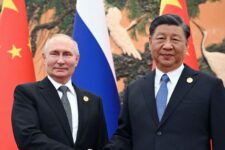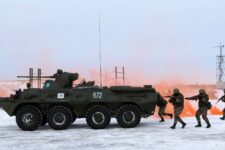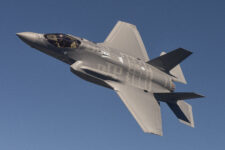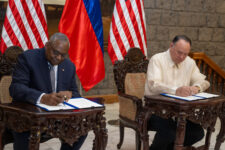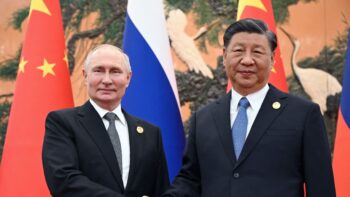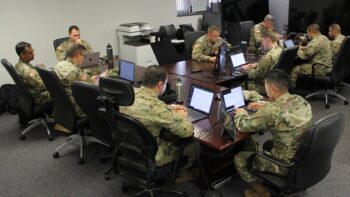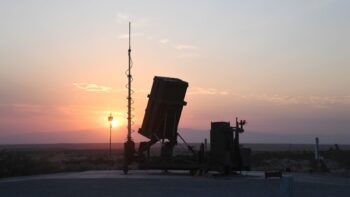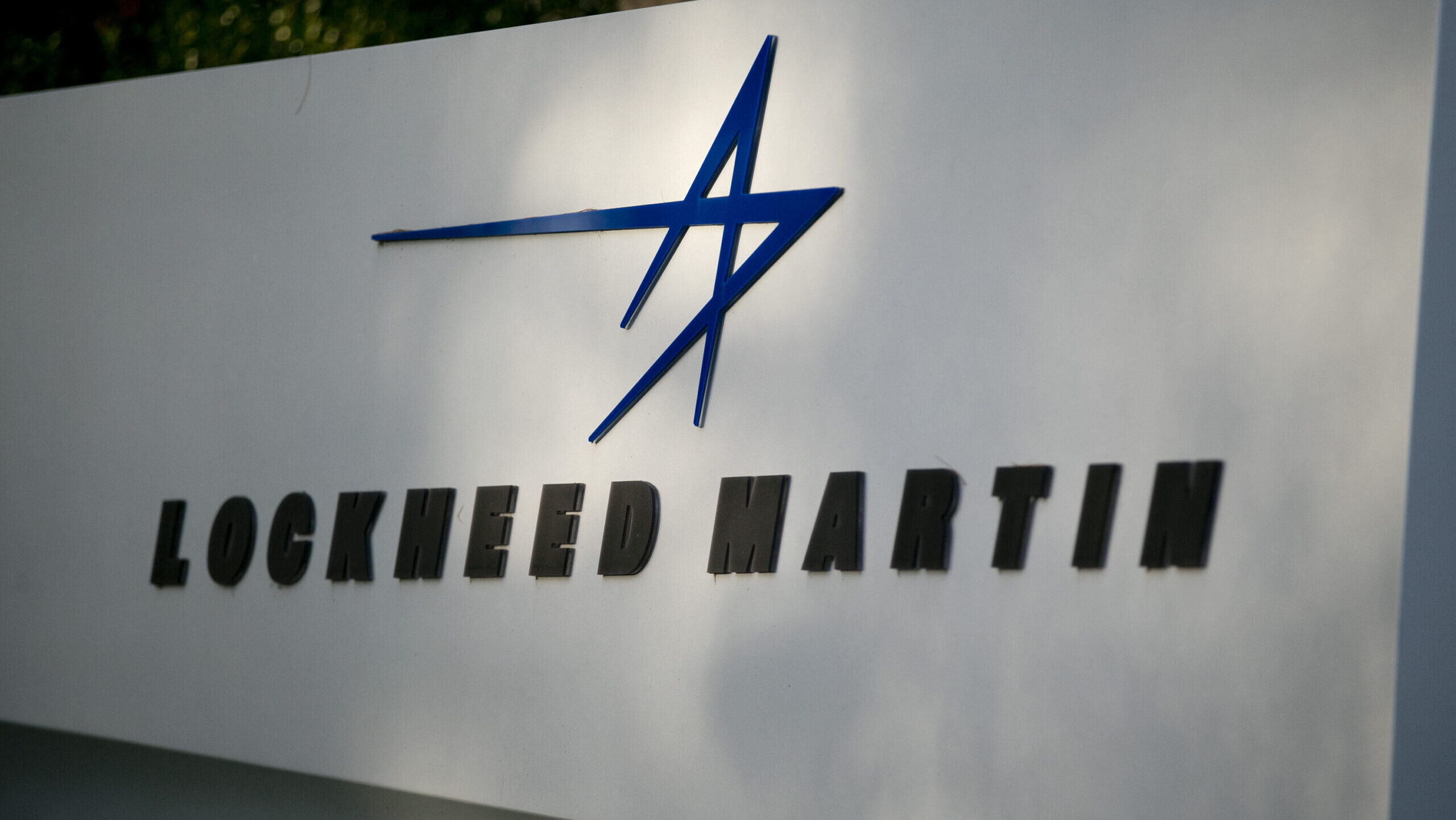
A sign for Lockheed Martin Corp. stands outside the company’s headquarters in Bethesda, Maryland, U.S., on Friday, Nov. 16, 2012. (Andrew Harrer/Bloomberg via Getty Images
WASHINGTON — Since coming out of the pandemic, Lockheed Martin has made industrial base resiliency a key priority. This month saw the defense giant move out that front in two key ways, announcing a plan to buy small satellite maker Terran Orbital as well as a partnership with General Dynamics to build solid rocket motors.
Over a recent phone call, Lockheed Martin Chief Operating Officer Frank St. John spoke to Breaking Defense about how the world’s top defense contractor is shaping up its supply chain, and how everything from the upcoming presidential election to inflation could impact the defense budget in the United States.
This interview has been edited lightly for length and clarity.
BREAKING DEFENSE: Lockheed recently announced a proposed acquisition of Terran Orbital and a partnership with General Dynamics to start development and production of solid rocket motors. On top of that, since the war in Ukraine the company has increased the number of coproduction agreements with international defense companies on a variety of programs. What should we expect in terms of future partnerships and acquisitions coming down the pipeline?
FRANK ST. JOHN: I think rather than seeing any one big movement, what we’re focused on is a whole range of things we need to do to improve the defense industrial base. In some cases, it will be targeted acquisitions of capability, like we saw with Terran Orbital, where there’s a unique technology that’s critical to delivering for our customers, and we think that we’re the better owner and better manager of that capability, so we bring that in house.
You’re also going to see a lot of customer funded alternate and second sourcing of key components within our systems, and that is to deal with some of the fragility that we saw coming out of COVID and going into the Ukraine demand ramp, and so we’re going to be adding alternate suppliers.
And then at the same time, we’re doing these agreements internationally with companies who have really good manufacturing — in some cases really good development capability — to have them participate in programs where we’re delivering capability into their country, but then also using that as a vehicle to make them part of our supply chain longer-term. Some good examples of that are Rheinmetall, which is going to be building midbodies for F-35. Not only those midbodies going into German aircraft, but also into other F-35 deliveries. We have several projects in Poland on programs like Javelin, PAC-3, creating a Polish version of HIMARS where they’re going to be delivering sub components, and in some cases with integration activities. And then if they learn on their own Polish programs how to do that work, then they become a future source for other follow-on activities. And then probably one of the more mature ones that’s happening is in Australia, where we’re going to be assembling and delivering guided MLRS rockets out of a munitions factory that we’re standing up in Australia.
So it’s a lot of things happening all at once. I don’t think you’re going to see, you know, one thing dominate. We’ve just got a full court press on trying to address some of the gaps that we saw over the last couple of years.
Anything big that we’re going to see over the next few months, before the end of 2024?
I don’t know that they’re going to happen necessarily by the end of the year.
The things that are happening on a pretty regular cadence are the international coproduction agreements. Almost every month, there’s something happening on the international front where we’re signing an MOU, we’re cutting a ribbon, we’re letting the contract. So I think there’s going to be a pretty regular cadence of those kind of things.
Mergers and acquisitions are sporadic and hard to predict any kind of timing on those sorts of things.
Let’s switch gears and discuss the budget. With the upcoming presidential election, it’s very likely the Pentagon will be stuck in a continuing resolution (CR) through the rest of the year. Does Lockheed have any particular concerns about what that could mean for its business?
CRs are problematic always, and in an election year, they tend to take a little longer to resolve themselves. As we’ve said in years past, the CRs create challenges in terms of funding stability. Oftentimes you have to bridge across the CR [to resolve challenges] with supply chain. Any new start programs become challenging because you have to wait until the CR clears to begin those.
Having said all that, it is something that we have a history of working our way through. We don’t see any particular challenges in this case.
And with regards to the election, we think that deterrence and deterrence capabilities are an enduring theme, regardless of which party is in the executive branch or who’s in control of Congress. And so we think our programs are well supported in the in the budget, and we’re looking forward to working with whatever the new administration looks like.
RELATED: Tired of being ‘shock absorber’ on inflation, defense industry wants new protections: AIA chief
What is your expectation for the defense budget topline over the next few years, and how much of that is dependent on who wins the election?
What we’re currently seeing is a flat or a declining real purchasing power to inflation.
We are watching as the budget goes through the congressional process. We’re seeing some movement to maybe [adding] program dollars above the spending caps, and we’re watching that with great interest. The other thing I would say is that historically, over the years, we’ve seen supplemental funding that has come in for things like Ukraine, for support for conflict in Israel, and other supplemental adds.
[But] it’s kind of too early at this point to make a call where that’s eventually going to land.
How do you see the health of Lockheed’s supply chain right now, and where are there still vulnerabilities? Are there any specific places you can point to where the company will be seeking alternate suppliers?
In general, I would say the supply chain has stabilized. Unfortunately, [it] has stabilized at a lead time and a capacity point that creates challenges for us on a go-forward basis, and that’s giving us the opportunity to find new suppliers, to augment and expand the capacity within the industry.
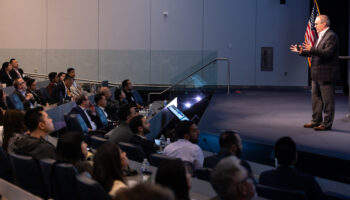
Lockheed COO Frank St. John speaks at a recent conference in Bethesda, Md. (Lockheed Martin)
In particular places within the supply chain, we still have some real challenges, things like raw materials, rare earth elements, titanium, micro electronics. There’s still a demand that’s exceeding the supply, and so that’s driving some lead times and some cost pressure. Also within our supply chain, we’ve had a pretty significant turnover in their workforce. A lot of people left the workforce during the COVID years. We’ve hired new people, but there’s some learning that has to take place within that workforce to be able to deliver with the same pace and the same quality that we were seeing pre-pandemic.
RELATED: Lockheed, Howmet settle lawsuit over F-35 titanium
All of that, I guess I would say, specifically to our business, manifests itself in some challenges on things like missile sensors, solid rocket motors, some things that are very unique to our industry, that require some specialized labor and learning. We’re still challenged, and that is in some ways holding back some additional growth that we could see in the business.
But at the same time, we’re working through it. This agreement we signed with General Dynamics is one step in creating additional capacity there, and we’re going to unlock some additional sources of supply, and we’re going to realize the growth potential that’s there.
On a program like F-35, how do you navigate those supply chain challenges and financial pressures like inflation while dealing with your smallest suppliers?
More than half of our supply chain is small suppliers. We have about 6,500 of them that are in our supply chain. We continue to provide subject matter expertise to them to help them be successful in delivering their products. We continue to, where needed, provide them favorable terms on their contracts so that they’re not too heavily impacted by some of the economic factors that are out there.
And quite honestly, the most challenging positions that we have in our supply chain come from the big industry partners we have that are our suppliers. The real challenge we have there is working with them to make sure that they’re overcoming these labor challenges that I mentioned, and that they’re delivering a quality product. We are having to do some extra effort on behalf of the small suppliers, but it’s some of the larger ones that are proving to be the bigger challenges.
When you talk about those larger suppliers, you’re talking more about the major first-tier companies?
Yes, yes.
